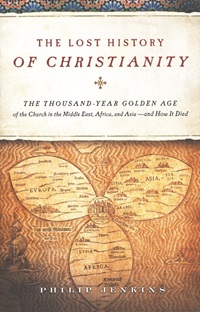Reading Philip Jenkins's history of Eastern Christianity yields some interesting insights.

In a couple of weeks, we'll publish a full review of Philip Jenkins's The Lost History of Christianity on the Christian History website. The book is a wide-ranging study of how religions cope with pressures from changing political fortunes and competing religions - and of how religions fail in the face of such pressures. The author's main case study is that family of Eastern Christian churches known as Monophysite, Jacobite, Nestorian, or non-Chalcedonian, once a powerful religion from Syria to India and an influence for a while on China. But those churches have been brought to greatly reduced circumstances and in some places extinguished. Jenkins asks why and draws lessons for dealing with contemporary threats to Christianity.
I'll leave the evaluation of the book to our reviewer, David Koyzis of Redeemer College. For the moment, I'd like to whet your appetite with two tidbits gleaned from my reading of the book.
Constructing Islam on Christian Foundations
First tidbit: Jenkins stresses how much Islam, Christianity's main competitor in the lands where Nestorians once dominated, borrowed from Christian sources. Much about Islam seems strange to Western observers. But to Syriac and Mesopotamian Christians in Islam's early years, much would have seemed very familiar - familiar to the point that Islam's closest Christian critic, John of Damascus, treated it as a Christian heresy rather than as a distinct religion.
Jenkins writes:
Mosques look as they do because their appearance derives from that of Eastern Christian churches in the early days of Islam. Likewise, most of the religious practices of the believers within those mosques stem from the example of Eastern Christians, including the prostrations that appear so alien to modern Westerners. The severe self-denial of Ramadan was originally based on the Eastern practice of Lent. The Quran itself often shows startling parallels with Eastern Christian scriptures, devotional texts, and hymns.
As to those Christian sources for Quranic materials, later in the book Jenkins writes that "most of the Quranic stories about Mary and Jesus find their parallels not in the canonical four Gospels but in apocryphal texts that circulated widely in the East. ... The Quran also presents the death of Jesus in exactly the language of those heretical Eastern Christians known as Docetists, who saw the event as an illusion rather than a concrete reality."
No wonder early observers thought of it as a heresy rather than a different religion. And no wonder it was able to ease the transition of early adherents.
Where the Church Lives Despite Persecution
Second tidbit: Jenkins poses the question as to why Christianity survived in some places where Islam became dominant and almost completely disappeared in others. He chooses as his case studies the Coptic Christians in Egypt (successful survival) and the church in the North African territories around Tunis and Carthage (total eradication of the Christian population).
Both Christian civilizations were overrun by Muslim forces. But the Copts survived and today they continue to thrive spiritually in spite of repressive political and cultural forces. But the North African churches where Tertullian, Cyprian, and Augustine had ministered simply disappeared.
What was the difference? The culture of the church at Carthage was Latin, and, Jenkins writes, "where the [North] African church failed was in not carrying Christianity beyond the Romanized inhabitants of the cities and the great estates, and not sinking roots into the world of the native peoples." St. Augustine "by far the best known of African bishops ... expressed no interest in the rural areas or peoples of his diocese."
The Copts of Egypt present a great contrast. Although theologians like Athanasius wrote and spoke Greek, the philosophical lingua franca of their times, the Coptic church was anchored in popular movements and the language of indigenous people. Its monastic movement was a key factor. St. Anthony, the desert monk who pioneered monasticism, spoke the people's Coptic and no Greek, and he drew his fierce spiritual warriors from among the common people. The Coptic Church had sophisticated theological and spiritual literature in the people's native tongue from early days. By the time the Muslims arrived in the seventh century, the church had long been thoroughly indigenized.
In urban cultures, a hostile religious or political force can banish church leaders and severely restrict the activities of believers. But as a general rule, in the countryside and in the villages, such tight control is very difficult. Thus churches that thoroughly indigenize have a greater chance of surviving hostile turns of history.
* * *
Jenkins's book is full of information about the Church of the East and insights about what factors contribute to the survival or extinction of religions. There's much here worth pondering. Watch for the full review in January.

Support Our Work
Subscribe to CT for less than $4.25/month




























